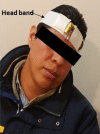Assessment of Postural Compliance After Pneumatic Retinopexy
- PMID: 31106032
- PMCID: PMC6502068
- DOI: 10.1167/tvst.8.3.4
Assessment of Postural Compliance After Pneumatic Retinopexy
Abstract
Purpose: We describe the functioning of a novel device, aimed to assess patient head position after a pneumatic retinopexy.
Methods: We enrolled patients with the clinical diagnosis of rhegmatogenous retinal detachment. All patients were asked to wear a specially designed headband with a monitoring device composed of an accelerometer, gyroscope, and magnetometer, powered by a 3.7V lithium battery. Every 200 ms, the device measured neck flexion and extension, left and right rotation, and left and right flexion. Patients were asked to come back the next morning for follow-up and headband retrieving.
Results: The device was worn an average of 19.17 ± 2.1 hours and performed a mean number of 57,670 ± 8663 measurements without power failures or program errors. An acceptable head position was kept for a mean of 3.33 ± 1.8 hours. The hardest axis to maintain was the right and left flexion of the neck (5.5 ± 2.54 hours of acceptable positioning).
Conclusion: Real-time monitoring of patient head position after a vitreoretinal procedure is feasible. Maintaining a fixed head position for more than 5 consecutive hours is difficult to achieve and physicians should consider this difficulty when planning treatment.
Translational relevance: In addition to a significant improvement to the basic design of similar devices, our device allows for assessment of patient adherence to postoperative instructions objectively for the first time to our knowledge. This information could be used in the future to elaborate more detailed position nomograms to improve outcomes.
Keywords: biomarkers; pneumatic retinopexy; real-time; retinal detachment; tracking device.
Figures



References
-
- Hilton GF, Grizzard WS. Pneumatic retinopexy. A two-step outpatient operation without conjunctival incision. Ophthalmology. 1986;93:626–641. - PubMed
-
- Hilton GF, Das T, Majji AB, Jalali S. Pneumatic retinopexy: principles and practice. Indian J Ophthalmol. 1996;44:131–143. - PubMed
-
- Tornambe PE, Hilton GF, Kelly NF, Salzano TC, Wells JW, Wendel RT. Expanded indications for pneumatic retinopexy. Ophthalmology. 1988;95:597–600. - PubMed
-
- Rahat F, Nowroozzadeh MH, Rahimi M, et al. Pneumatic retinopexy for primary repair of rhegmatogenous retinal detachments. Retina. 2015;35:1247–1255. - PubMed
-
- Hilton GF, Kelly NE, Salzano TC, Tornambe PE, Wells JW, Wendel RT. Pneumatic retinopexy. A collaborative report of the first 100 cases. Ophthalmology. 1987;94:307–314. - PubMed
LinkOut - more resources
Full Text Sources

